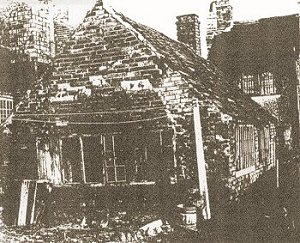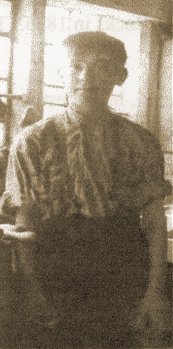|
First
Generation
John and
Mary Worrall
John Worrall (1754 - 1834) settled in Willenhall during the
1780s. Like many in the Willenhall area, he used a small
building at the back of his house to make locks. There was no
machinery in those days; the locks had to be made entirely by
hand. The master locksmith was intelligent and inventive,
John and Mary had three children, who were baptised in St.
Giles’ Church, Willenhall.
Second
Generation
|
William |
John (1788-1851) |
Elizabeth |
Lock makers taught their sons to make locks at a very early age,
maybe as young as nine or ten. It was usual for family members to
help with the business, as young John did. The children rarely
received a school education, but they became professionals in their
trade.
Young John Worrall married Mary Taylor on the 5th April 1812 in St.
Peter's Church, Wolverhampton. They had four sons, who also became
locksmiths.
|
 |
This picture, taken in the mid twentieth century, shows a derelict lock
factory at the back of a house in Willenhall. In the 18th and 19th
centuries this building would have been just one of the many used in the
family lock making industry, but naturally it would have been in better
condition. |
|
Third Generation
Daniel
(1813-1877)
born in
Willenhall |
Thomas
(1818-1894)
born in
Willenhall |
David
born in
Walsall |
John
born in
Willenhall |
And so father, son and grandsons would be at their workbenches each
day making the different parts that would eventually become a lock,
which was a hard job. They relied on the locally found coal and iron
to produce the wrought iron needed for the locks. The iron was
bought in round or square bars and hammered over the anvil, usually
at night. Parts were hammered out to a rough size and then filed
down to shape. The file and hammer were in fact the most important
tools of the locksmith. Any holes in the locks were punched in over
the anvil or drilled out with a bow and stock, a process carried on
until very late into the nineteenth century.
|
|
To sell their products the master of the firm used to travel every
Saturday to the factors in Wolverhampton or even Birmingham, and return
with orders for the next week or so. Padlocks could be sold in the
nineteenth century at a wholesale price of 6/6d. per gross and retail at
a penny each.
In 1833, according to the Bridgen’s Directory of the Borough of
Wolverhampton, John Worrall was a Rim Locksmith, of New Square [maybe
New Street], Willenhall. In 1834, at the age of 78, John Worrall senior
died. His son, John, carried on the business of lock making and moved to
Walsall Street.
|

This is from an etching by an unknown artist of the locksmith's forge in
the late eighteenth century.
|
|
Daniel, his eldest son (1813 - 1877) also worked in the business. He
married Ellen Meanley from Bromley, Niddlesex and after their son,
Thomas, was born in 1837 they moved to East St. George, London,
where they had two more sons. During the time they lived there
Daniel was employed as a locksmith.
Fourth Generation
Thomas
(1837-1900s)
born in
Willenhall |
Daniel
born in
London |
George
born in
London |
In 1841 when the first national census was taken, John and Mary
Worrall, who were in their fifties, were living with three of their
sons, Thomas, David and John (who were the third generation), and
making locks in King Street, Willenhall. Also living with them and
working in the lock factory were four apprentices whose ages were
10, 11, 12 and 14, and a labourer. The ten-year-old apprentice was
named John Hunt, whose father had died.
As apprentices were a cheap form of labour for the lock makers, they
deserve a mention, as they were a part of the history of the
lockmaking trade. |
 |
Children who were in the care of the Parochial Officers or in the
Workhouse were placed as apprentices to the lock-makers, to spend
ten years as members of their household. Some were badly treated and
made to work long hours, sometimes from dawn to dusk each day with
very little to eat and sometimes poor food.
The Apprentices often developed humped backs; because of their age
their bones were still undeveloped.
This pictures shows how they had to stand for many hours in an
unnatural position whilst they filed the metal.
A lot of them died from consumption or other ailments because of the
cramped space in the workshops. |
|
When nearing the end of his apprenticeship, at around the age of
twenty or twenty one, an apprentice had to design and make a lock
entirely on his own. These locks were usually very decorative, and
had a very complex system of wards. They would often have unusual
extras, such as a set of chimes that played when the bolt was
“shot”, or an indicator to show the number of times the lock had to
be used. These locks were then sold for a very high price by the
apprentice's master.
The qualified apprentices then moved on, sometimes being
self-employed as a Journeyman Locksmith travelling the country, as
the master could not afford to pay them a man's wage. |
|
This young boy, Alexander Pitt, born in 1895 was twelve years old and
working in a lock factory when this picture was taken. He had left
school when he was eleven.
He had been a pupil at the Catholic School where the parents had to
pay threepence per week for their children's education. Children at
that time had to stay at school until they were twelve years old,
and so his parents had to continue paying threepence per week until
he could officially leave school.
His job in the lock factory was filing, which was a hard job.
Because he wasn't tall enough to reach the bench, he had to stand on
a box to carry out this arduous task.
|
 |

|
|

|
| Return to
the Gazetteer |
|
Proceed to
Part Two |
|